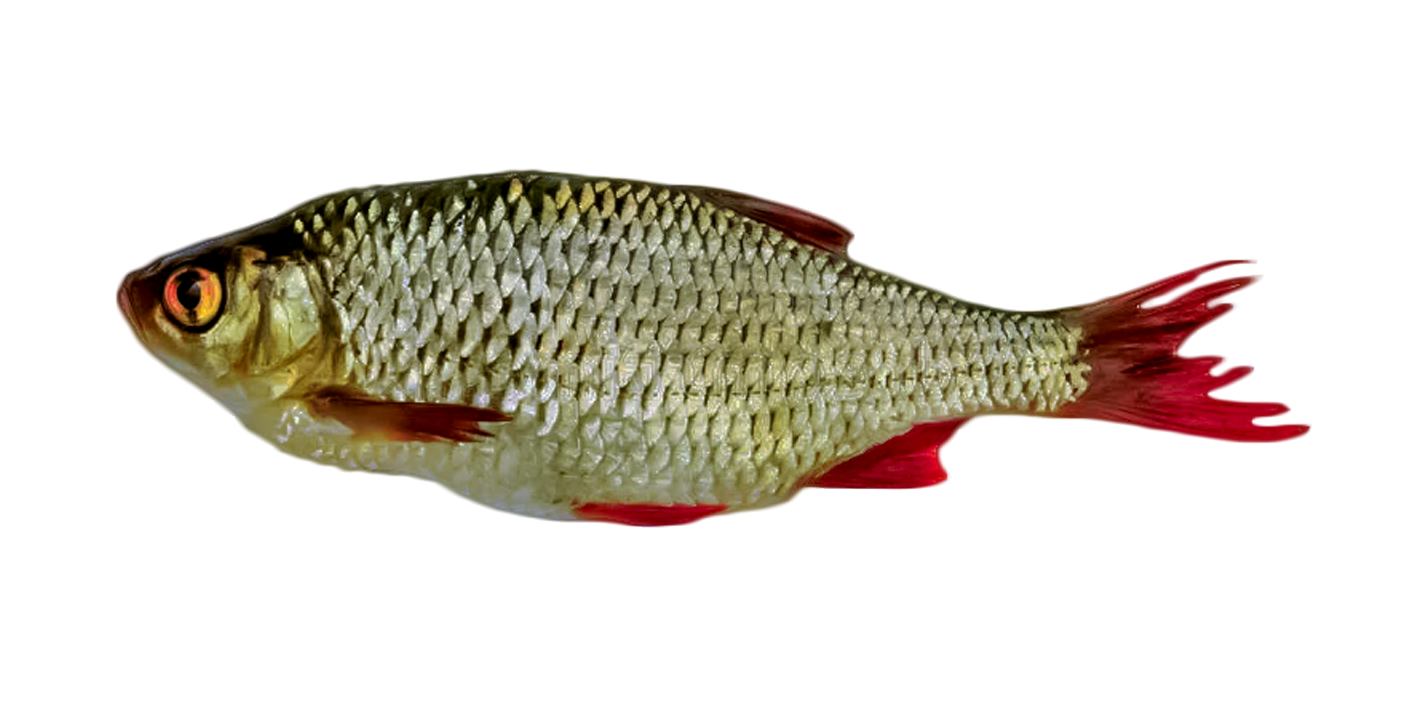

"Popular among anglers because it takes bait so readily, the red-finned Rudd is often regarded as Britain's most colourful freshwater fish".

Rudd (Scardinius erythrophthalmus)
Appearance: coppery golden in colour with bright blood-red fins and an upturned mouth for surface feeding.
British record: 4lb 10oz (British record committee 2015)
Lateral line scale count: 40-55 (this is the dark row of scales along the central length of the fish's body)
Lifespan: 8 to 14 years
Easy to confuse at first glance with its close relative the Roach.
Yes, it can be easy to confuse, at
first glance, Rudd with its close relative the Roach, the Rudd can be recognized by
its red fins (brighter on the underside), deep bronze-gold flanks and a
distinctive steeply angled, protruding lower lip.
(The Roach, less vividly
coloured, has silvery flanks, dull orange Fins and a receding lower Lip.)
The Rudd is common in still-waters throughout southern England and in Ireland, but is rare in northern England. It is hardly ever found in Scotland or Wales, however.
Another identifying feature in the Rudd is that the beginning of its Dorsal Fin is set well behind the front of the Pelvic Fins - in Roach the Dorsal Fin is directly above the base of the Pelvic Fins. The Rudd also has a sharp ridge, or 'keel', between the Pelvic Fin and the Anal Fin.
Rudd and Roach 'hybridize' freely and there is great confusion about its identity when a 'hybrid' is caught. One way of checking a hybrid is to look at the lips - the Roach/Rudd hybrid often has equal lips, neither 'protruding' nor 'receding'.
Positive identification is only important when the catch may qualify for a new record. In this case the fish may have to be killed so that experts can examine its pharyngeal (throat) teeth.
Rudd have two rows of throat teeth, while roach have only one row.
Hybrids, intermediate between the two, have only a partial second row. The Rudd's body is deep and a large well-fed specimen can be very broad across the shoulders. The Rudd is mainly a fish of still waters, with few populations thriving in rivers. Rudd prefer reed or tree-lined waters where it can feed on fallen Insects using its well-adapted mouth. The Norfolk Broads, England are ideal Rudd habitat, but gravel pits, ponds, canals and lakes also have good populations.
Only nutrient-rich waters support large numbers of Rudd. For some reason they tend to overpopulate suitable waters, resulting in thousands of stunted fish.

Because of the shape of the mouth - with the protruding lower lip - Rudd feed more on the surface than roach.
In warm weather they lie in shoals just under the surface, feeding on insects of all kinds.
Rudd also take a variety of crustaceans and snails from the bottom, and a limited amount of plant matter - foraging about among weeds and reeds in the margins and middle depths of the water.
Large specimens occasionally take fish fry, while the young - like most members of the Carp family - feed on animal plankton.
Rudd are known to come readily to a variety of baits - Sweetcorn, Maggots, Bread and so on - but shoals take fright very easily, bolting away at the slightest disturbance.
Because the fish scare so quickly, they are tricky to approach, and it can sometimes be quite difficult to catch more than one or two from a large shoal.
Rudd spawn at the end of May or early June, each female shedding anything from 90,000 to 200,000 tiny transparent yellow eggs which stick on to weeds and reed stems.
The young, which hatch after six to eight days, are no larger than the head of a pin and spend the first part of their life sheltering in shoals in the water margins.
As the fry grow larger, they move out into deeper water and begin to feed on Insects - both adults and larvae.
Rudd are fairly slow-growing and in some waters can take up to four years to reach maturity. Unfortunately, the Rudd is declining in many waters perhaps because of competition from other fish - Roach in particular.
About fifty years ago Roach were rare in Ireland, where they are not native. But in recent years the populations of introduced Roach have pushed the Rudd into the background in many places.
The situation is similar in quite a few waters in England.
